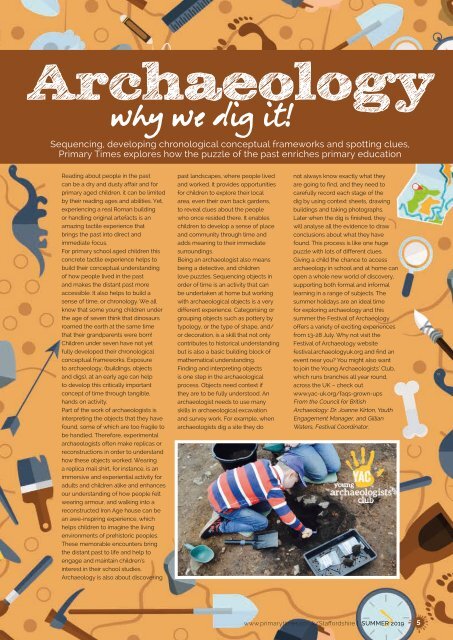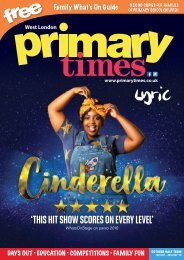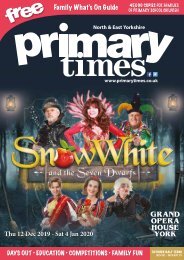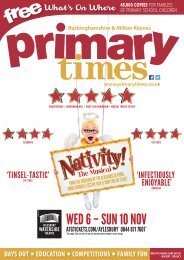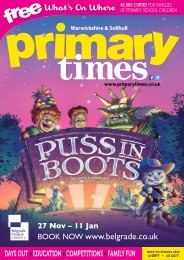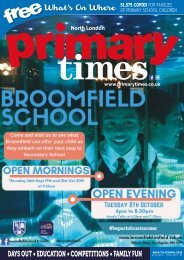PT STAFF Summer 2019
Create successful ePaper yourself
Turn your PDF publications into a flip-book with our unique Google optimized e-Paper software.
Primary Times Staffordshire<br />
Archaeology<br />
why we dig it!<br />
Sequencing, developing chronological conceptual frameworks and spotting clues,<br />
Primary Times explores how the puzzle of the past enriches primary education<br />
Reading about people in the past<br />
can be a dry and dusty affair and for<br />
primary aged children, it can be limited<br />
by their reading ages and abilities. Yet,<br />
experiencing a real Roman building<br />
or handling original artefacts is an<br />
amazing tactile experience that<br />
brings the past into direct and<br />
immediate focus.<br />
For primary school aged children this<br />
concrete tactile experience helps to<br />
build their conceptual understanding<br />
of how people lived in the past<br />
and makes the distant past more<br />
accessible. It also helps to build a<br />
sense of time, or chronology. We all<br />
know that some young children under<br />
the age of seven think that dinosaurs<br />
roamed the earth at the same time<br />
that their grandparents were born!<br />
Children under seven have not yet<br />
fully developed their chronological<br />
conceptual frameworks. Exposure<br />
to archaeology, (buildings, objects<br />
and digs), at an early age can help<br />
to develop this critically important<br />
concept of time through tangible,<br />
hands on activity.<br />
Part of the work of archaeologists is<br />
interpreting the objects that they have<br />
found, some of which are too fragile to<br />
be handled. Therefore, experimental<br />
archaeologists often make replicas or<br />
reconstructions in order to understand<br />
how these objects worked. Wearing<br />
a replica mail shirt, for instance, is an<br />
immersive and experiential activity for<br />
adults and children alike and enhances<br />
our understanding of how people felt<br />
wearing armour, and walking into a<br />
reconstructed Iron Age house can be<br />
an awe-inspiring experience, which<br />
helps children to imagine the living<br />
environments of prehistoric peoples.<br />
These memorable encounters bring<br />
the distant past to life and help to<br />
engage and maintain children’s<br />
interest in their school studies.<br />
Archaeology is also about discovering<br />
past landscapes, where people lived<br />
and worked. It provides opportunities<br />
for children to explore their local<br />
area, even their own back gardens,<br />
to reveal clues about the people<br />
who once resided there. It enables<br />
children to develop a sense of place<br />
and community through time and<br />
adds meaning to their immediate<br />
surroundings.<br />
Being an archaeologist also means<br />
being a detective, and children<br />
love puzzles. Sequencing objects in<br />
order of time is an activity that can<br />
be undertaken at home but working<br />
with archaeological objects is a very<br />
different experience. Categorising or<br />
grouping objects such as pottery by<br />
typology, or the type of shape, and/<br />
or decoration, is a skill that not only<br />
contributes to historical understanding<br />
but is also a basic building block of<br />
mathematical understanding.<br />
Finding and interpreting objects<br />
is one step in the archaeological<br />
process. Objects need context if<br />
they are to be fully understood. An<br />
archaeologist needs to use many<br />
skills in archaeological excavation<br />
and survey work. For example, when<br />
archaeologists dig a site they do<br />
not always know exactly what they<br />
are going to find, and they need to<br />
carefully record each stage of the<br />
dig by using context sheets, drawing<br />
buildings and taking photographs.<br />
Later when the dig is finished, they<br />
will analyse all the evidence to draw<br />
conclusions about what they have<br />
found. This process is like one huge<br />
puzzle with lots of different clues.<br />
Giving a child the chance to access<br />
archaeology in school and at home can<br />
open a whole new world of discovery,<br />
supporting both formal and informal<br />
learning in a range of subjects. The<br />
summer holidays are an ideal time<br />
for exploring archaeology and this<br />
summer the Festival of Archaeology<br />
offers a variety of exciting experiences<br />
from 13-28 July. Why not visit the<br />
Festival of Archaeology website<br />
festival.archaeologyuk.org and find an<br />
event near you? You might also want<br />
to join the Young Archaeologists’ Club,<br />
which runs branches all year round,<br />
across the UK – check out<br />
www.yac-uk.org/faqs-grown-ups<br />
From the Council for British<br />
Archaeology: Dr. Joanne Kirton, Youth<br />
Engagement Manager, and Gillian<br />
Waters, Festival Coordinator.<br />
www.primarytimes.co.uk/Staffordshire | SUMMER <strong>2019</strong> 5


